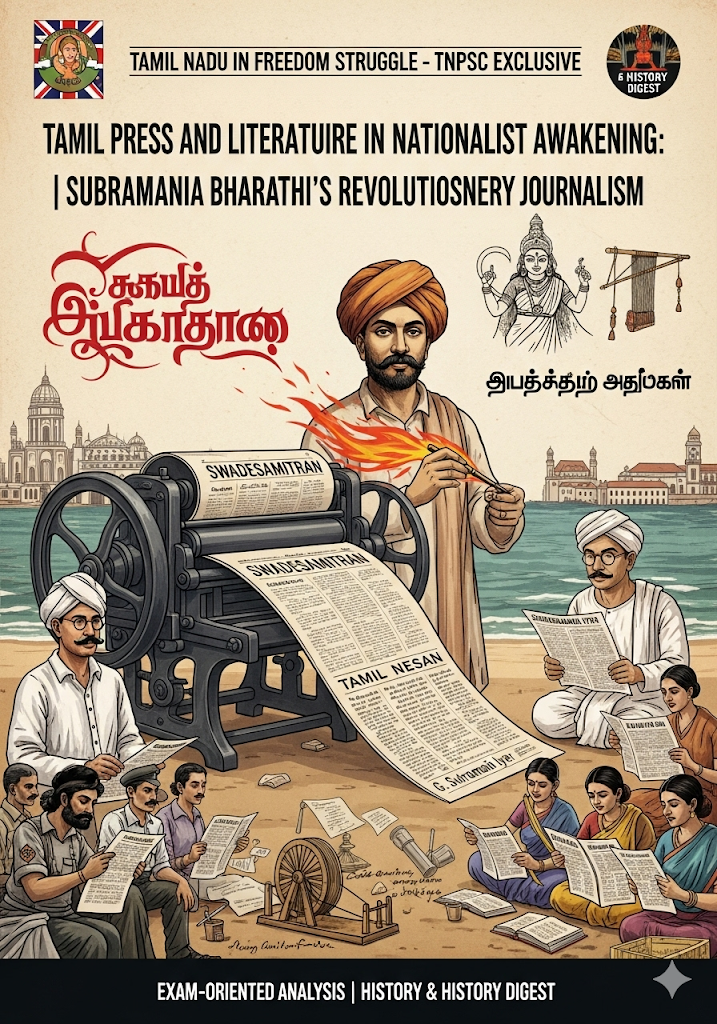
Tamil Press and Literature in Nationalist Awakening: Catalyzing Political Consciousness in Tamil Nadu
The Revolutionary Power of Vernacular Journalism and Subramania Bharathi’s Literary Nationalism
Growth and Foundation of Tamil Press
• Pioneering Publications: Swadesamitran (1882) emerged as the flagship Tamil newspaper, followed by India and Tamil Nesan, creating a robust vernacular media network that reached educated Tamil society
• G. Subramania Iyer’s Leadership: As founder-editor of Swadesamitran and later The Hindu, Iyer established professional journalism standards while promoting nationalist ideology through measured yet impactful editorial content
• Institutional Development: Tamil press evolved from religious and social reform publications to politically conscious media outlets that challenged colonial narratives and promoted indigenous perspectives
Subramania Bharathi: The Revolutionary Poet-Journalist
• Dual Role as Writer and Activist: Bharathi combined his poetic genius with militant journalism, using Swadesamitran and India as platforms to propagate revolutionary nationalism through accessible Tamil prose
• Literary Nationalism: His patriotic poetry like “Vande Mataram” translations and original compositions such as “Tamil Thai Vazhthu” transformed abstract nationalist concepts into emotionally resonant cultural symbols
• Revolutionary Ideology: Bharathi’s writings promoted complete independence (Purna Swaraj), women’s liberation, and social equality, making him a pioneer of progressive nationalism in South India
Vernacular Journalism’s Political Impact
• Cultural Accessibility: Tamil press bridged the gap between English-educated elites and common people by presenting political ideas through familiar cultural idioms, folklore, and religious metaphors
• Swadeshi Movement Mobilization: Newspapers actively promoted economic boycott of British goods, encouraging handloom industries and indigenous enterprises through detailed coverage and editorial campaigns
• Rural Penetration: Vernacular journalism reached village communities through shared reading sessions, creating political awareness among agriculturalists and artisans previously excluded from nationalist discourse
Government Repression and Underground Resistance
• Censorship Challenges: Colonial authorities imposed Press Acts and sedition cases against Tamil journalists, leading to publications operating underground or from French territories like Pondicherry
• Creative Resistance: Writers and journalists developed coded language, allegories, and mythological references to convey nationalist messages while evading censorship
Women’s Participation and Social Transformation
• Literary Encouragement: Bharathi’s progressive writings on women’s education and participation inspired female readership and contributed to women’s involvement in freedom struggle activities
• Social Reform Integration: Tamil press linked political nationalism with social reforms, addressing caste issues, women’s rights, and educational advancement simultaneously
Long-term Influence on Tamil Political Consciousness
• Cultural Foundation: The vernacular press created a distinct Tamil nationalist identity that later influenced Dravidian political movements and continues to shape Tamil Nadu’s political discourse today
